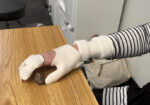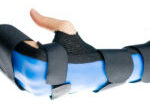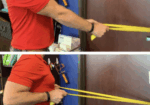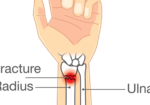Extensor Tendon Repair Protocol (zone 4-7): Immediate Controlled Active Motion (ICAM)
Filed under Reviews, Treatments
Howell, J.W., Merritt, W. H., & Robinson, S. J. (2005). Immediate Controlled Active Motion Following Zone 4–7 Extensor Tendon Repair. Journal of hand therapy: 18, 182-90.
The Skinny- For years immobilization was the standard procedure following extensor tendon injuries in zones 4-7. As expected immobilization caused lengthy rehabilitation times, stiff joints, and tendon adhesions often leading to capsulotomy or tenolysis procedures. This study sought to provide an alternative, using an immediate controlled active motion (ICAM) protocol with a two-part orthosis program (ICAM extensor tendon protocol). A total of 140 patients took part in the study
In The Weeds- Each participant followed a three-phase rehab protocol.
Phase 1: Participants wore the two-part orthosis for 21 days, which consisted of a yoke orthosis on the involved digits with the MP joint(s) in 15-20 degrees extension, and a volar wrist orthosis with the wrist placed in 20-25 degrees of extension.
Phase 2: Participants wore the yoke orthosis at all times and wrist orthosis during medium to heavy-duty type tasks for days 22-35 post surgery.
Phase 3: Participants were to discharge the wrist orthosis entirely and only use the yoke orthosis for 36-49 post surgery. All orthoses were d/c after 49 days post surgery.
The protocol is an option when one digit is affected or two digits if not IF+LF or RF+SF. It is not recommended for 3-4 digit involvement.
Results: No extension lag was found in 114 patients, and no terminal flexion loss was found in 111 patients. Patients that saw some extension lag or terminal flexion loss were complex tendon injuries. Grip strength at time of discharge averaged 85% of the uninjured hand. No complications such as ruptured tendons, infections, or pain syndromes occurred. No secondary surgeries such as tenolysis or capsulotomies were required.
Bringing it Home- This study demonstrated patients with extensor tendon injuries in zones 4-7 can safely perform immediate controlled active motion using a yoke splint on the fingers and a wrist extension orthosis, each with specified degrees of extension. Excellent outcomes included reducing extensor lags, return of strength, average return to work in 18 days, and an average discharge of seven weeks.
Taking into account this study’s thorough anatomical cadaver testing trials, large patient sample size, specific inclusion criteria with documentation of varying complexities of tendon injuries within its sample, and transparent data analysis, it is a reliable source to inform your practice. Detailed tutorials with pictures on how to make the two-part orthosis are also included in the text.
More To Read
What to Know as a Hand Therapist When Choosing Thermoplastic Orthosis Material
By: Kelsey Melton Thermoplastic materials can have a variety of properties. Each supplier has a different version of each combination of variables for the therapist to choose from. The most common brands used for orthosis fabrication are Orfit, NorthCoast Medical (NCM), and Raylan. These brands all have their versions of thermoplastic material that vary in…
Read MoreFlexor tendon rehabilitation in the 21st century: A systematic review
Neiduski, R. L. & Powell, R. K. (2019). Flexor tendon rehabilitation in the 21st century: A systematic review. Journal of Hand Therapy, 32, 165-174. The Skinny The objective of the study was to determine if there was evidence to support 1 type of exercise regimen. Exercise regimens reviewed include place and holds, early passive or…
Read MoreIncrease Shoulder Range by Improving Scapulohumeral Rhythm
Scapulohumeral rhythm is often the key component when treating shoulder conditions and the lack of total shoulder range of motion. This may also be a critical component to prevent shoulder conditions during the rehabilitation of other upper extremity conditions such as distal radius fractures, tendon injuries, and elbow injuries. Scapulohumeral rhythm is the rhythm in…
Read MoreIs therapy needed after a distal radius fracture?
Coughlin T, Norrish AR, Scammell BE, Matthews PA, Nightingale J, Ollivere BJ. Comparison of rehabilitation interventions in nonoperatively treated distal radius fractures: a randomized controlled trial of effectiveness. Bone Joint J. 2021Jun;103-B(6):1033-1039. doi: 10.1302/0301-620X.103B.BJJ-2020-2026.R1.Epub 2021 Apr 30. PMID: 33926211. The Skinny: Individuals with distal radius fractures are very common in the hand therapy world. This…
Read MoreSign-up to Get Updates Straight to Your Inbox!
Sign up with us and we will send you regular blog posts on everything hand therapy, notices every time we upload new videos and tutorials, along with handout, protocols, and other useful information.






